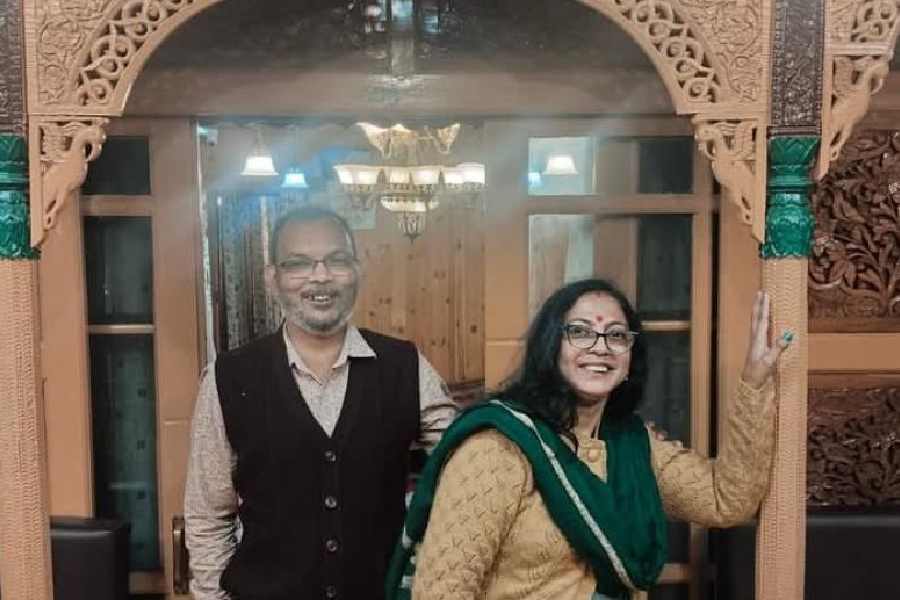 |
| Sanchita Ajjampur has gone for tufted silk and fur embroidery for a scavenged look |
Have you had an aching desire to go ethnic in a chic sort of way? Then tribal fashion — the trend that’s hotting up this winter — is just what the fashion doctor ordered for you. From motifs used by Naga tribes in their shawls to the much-loved animal prints of African tribes, designers are transposing a variety of symbols and elements from traditional tribal art in their ready-to-wear lines.
So, bright evening dresses are being detailed with tribal embellishments like feathers and bead-work while animal prints are back being trendy. Asymmetrical tops and kurtis embellished with vibrant tribal embroidery are also the way to go this season.
Designer Sanchita Ajjampur says: “Tribal fashion borrows patterns and ideas from cultures across the world and subtly works them on Western silhouettes. This infusion makes them stand out in the crowd.” The USP of this trend, she adds, is that it not only helps us connect with nature but also sounds the return of fun patterns and geometric shapes in a big way.
 |
| Cross-stitch and beaded embroidery that’s intrinsic to tribal art features prominently in Kavita Bhartia’s collection |
Since tribal fashion is marked by vibrant hues and motifs, designers Anita Dongre and Kavita Bhartia are going heavy on tribal-style colourful embroidery and patterns. “For my brand Global Desi, the inspiration came from the traditional red-and-black Naga shawls and artistic embroidery and mirror-work of the Rabari tribes of Kutch,” says Dongre.
To keep the aesthetics of tribal art intact, she got artisans from these two regions to work on the collection. Bhartia has kept her colour palette vibrant with blues, reds, yellow and greens that are so much a part of the tribal art of Rajasthan and Gujarat.
Bhartia has opted for tribal art elements like beaded and cross-stitch embroidery, geometrics and chunky metal work that are so intrinsic to the tribes of Kutch region of Gujarat and Rajasthan. “These have been given a contemporary spin in Western silhouettes like tunics and long dresses to make a hip fashion statement,” says Bhartia. She’s also picked bead-work from African tribes and used it along with dori-work and shading in her evening dresses that are priced between Rs 10,000 and Rs 15,000.
 |
| Tribal embellishments like this jute mesh as well as feathers find favour in Anand Bhushan’s line |
The favoured animal prints of African tribes have surfaced in the tribal lines of Anand Bhushan and Payal Jain. “My work is largely inspired by the art of the Akan tribe of Ghana and the Ivory Coast, the Hutu tribe of Rwanda and the Zulus of Africa,” says Bhushan. He’s all for animal skin textures and patterns like zebra- and giraffe prints while his collection is replete with tribal embellishments like feathers and jute mesh.
“We’ve also used tribal jewellery designs as detailing on the garments and motifs of tribal wall décor as appliqués,” says Bhushan. He’s strayed from the typical tribal colour board, and shaded the line in soothing neutrals like whites and mints with inserts of bright specks of red, salmon and green.
Jain’s tribal line, Black Ice, is not just about layering and drapes but also has plenty of tiger-, leopard- and zebra prints and elements like leaves and trees. “The inspiration for this collection came from the savage beauty of creatures who roam the terrain of Kilimanjaro,” says Jain. Bold monochromatic strokes and animal prints are splashed on delicate silk chiffons, georgettes, satins and jerseys in her Autumn-Winter line priced upwards of Rs 5,000.
 |
| Payal Jain has gone big on animal prints in her black and white collection |
Ajjampur, meanwhile, is treading a different path as she’s zoomed in on the warriors of Japan. “My inspiration for the tribal line came from the ancient Japanese Samurais,” says Ajjampur, who has given a modern spin to elements found on Samurai armour. So, the nuts and bolts in the armour have been interpreted in the form of colourful prints. The designer has also incorporated beading and glass patterns into her creations and used tufted silk, fur embroidery to achieve a scavenged look. The collection is priced upwards of Rs 3,000.
The collection comes in earthy tones of snow, ivory, nude, honey brown, moss green, willow grey and black rock. There are flashes of gilded gold and pewter to reflect the stark richness of the Japanese palette.
The designers have also made a conscious effort to make the clothes chic and wearable by keeping the silhouettes modern. Bhartia has opted for party-wear and casual dresses in stretchable fabrics like Lycra and jerseys and free flowing georgettes which are easy-to-wear.
Ajjampur’s collection on the other hand includes loads of T-shirts that can be worn everyday and short dresses in weaves combining chiffon and silk as well as jerseys.
So, unleash your wild side the stylish way to make a strong statement this winter!










